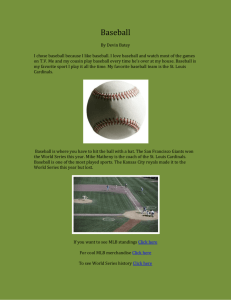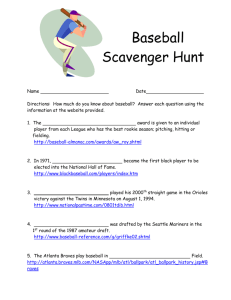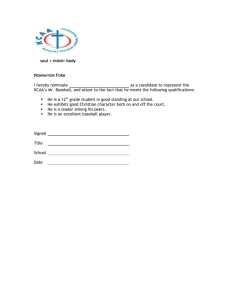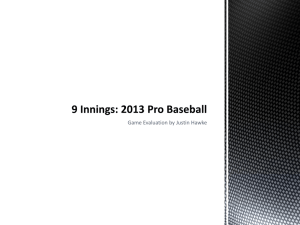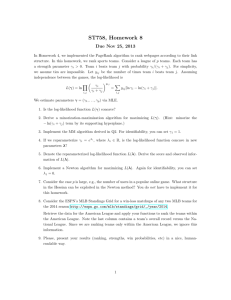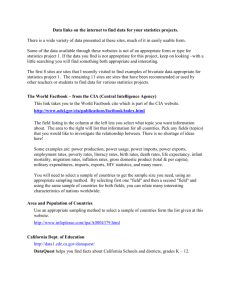The Economics of Baseball
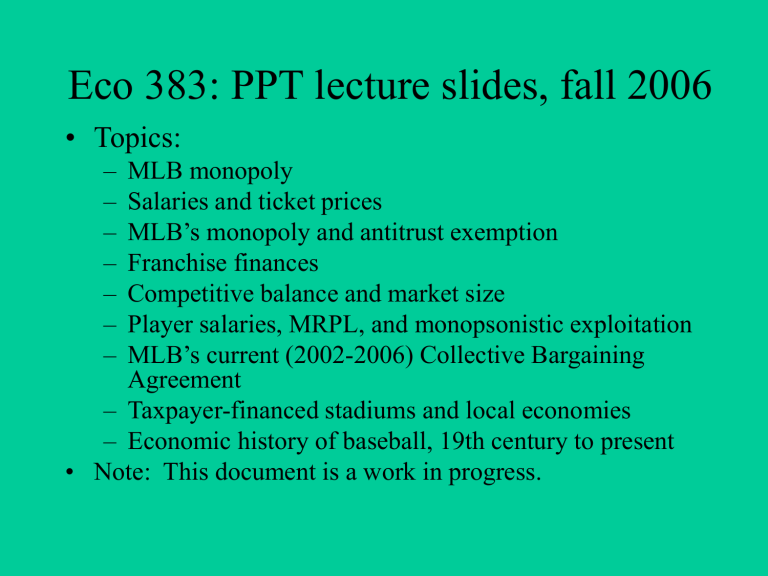
Eco 383: PPT lecture slides, fall 2006
• Topics:
– MLB monopoly
– Salaries and ticket prices
– MLB’s monopoly and antitrust exemption
– Franchise finances
– Competitive balance and market size
– Player salaries, MRPL, and monopsonistic exploitation
– MLB’s current (2002-2006) Collective Bargaining
Agreement
– Taxpayer-financed stadiums and local economies
– Economic history of baseball, 19th century to present
• Note: This document is a work in progress.
MLB as a monopoly league
• No other league provides a comparable product
• Prohibitive restrictions on entry
– Fan loyalties to existing teams
– Stadium construction costs
– MLB’s power to sign exclusive TV deals
• MLB, exempt from antitrust laws, has more license to squash competitors than most firms do.
Each MLB team as a monopoly
• Most MLB teams have a city all to themselves
– Even teams in the same city are not really substitutes
• Prohibitive restrictions on entry (of new teams)
– Expansion is rare.
• When it does occur, expansion fee is very high.
Salaries and ticket prices
• Q: Do higher player salaries cause higher ticket prices?
• A: NO, because player salaries are fixed costs, which are not part of marginal costs (MC) or marginal revenue (MR).
The price that equates MC and MR is the profitmaximizing price, regardless of the level of payroll.
• Ticket prices are essentially set by the level of DEMAND.
• 2001-2002: Average salary rose 5%, while average ticket price fell 4%
Q: What if a team increases its payroll by signing a superstar player? Wouldn’t that tend to increase ticket prices?
A: Yes, not because of the increase in (fixed) costs, but because of the increased DEMAND for tickets, which will cause the new profitmaximizing price to be higher.
In most recent years, MLB ticket prices have increased much faster than prices overall (e.g., 25% in 1999-2001, 6% in
2004-2005).
Why: Demand for games has gone up, thanks to --
• General U.S. prosperity
• Renewed interest in the game (cable TV coverage, homerun records, wild-card races, …)
• Attractive new stadiums (S.F., Pittsburgh; Baltimore,
Cleveland, Texas)
Eco 383, Feb. 10-17:
MLB as a monopoly sports league;
The antitrust exemption
• Topics:
– I. Pro sports leagues as monopolies
– II. Baseball’s antitrust exemption: A history
– III. Sports-league monopolies and the cities
– IV. What to do about MLB’s monopoly?
Baseball’s antitrust exemption (AE):
A history
• U.S. antitrust laws were passed in order to (1) break up monopolies and (2) prevent firms in the same industry from colluding with each other to set prices and output
– Sherman Antitrust Act (1890)
– Clayton Antitrust Act (1914)
• The National and American Leagues were sued by a Federal League team owner for antitrust violations around 1915. The case went through the courts, and to the Supreme Court in 1922.
History of Baseball’s AE (cont’d)
• Supreme Court, 1922: antitrust laws do not apply to baseball.
– Why: professional baseball games were not “interstate commerce” (which the federal government can constitutionally regulate)
– “exhibitions of baseball are purely state affairs”
• The Court has upheld the AE ever since.
– Respect for precedent ( stare decisis ).
MLB expansion over the years
• 1903-60: same 16 teams
• 1961-62: 4 new teams (total of 20)
• 1969: 4 new teams (total of 24)
• 1977: 2 new teams (total of 26)
• 1993: 2 new teams (total of 28)
• 1998: 2 new teams (total of 30)
Franchise relocations in MLB
• 1903-51: same 16 teams in same cities
• 1953-72: ten teams switched cities
• 1972-2004: no teams moved
– MLB’s antitrust exemption makes it easier for
MLB to prevent team movements
– Teams have territorial rights: can oppose another team’s locating within 75 miles of them
• 2005: one team moved (Expos to D.C.)
Curt Flood Act (1998)
• Named for the player who challenged MLB’s reserve clause in court in early
1970s
• Decreed that MLB’s antitrust exemption did not exempt MLB from U.S. labor laws
Curt Flood Act (continued)
• A result of the 1994-95 work stoppage
– Strike ended after a federal judge issued an injunction against the owners in 1995, ruling that the AE didn’t apply to labor issues.
– 1996 Collective Bargaining Agreement: owners and players agreed to press for a law to that effect
– Congress passed the law in 1998 without dissent or fanfare
• What is left of MLB’s antitrust exemption?
Some practical effects of MLB’s presumed antitrust exemption
• FEWER TEAM RELOCATIONS
– less migration of teams from small cities to big ones
• FEWER TEAMS
• The RESERVE CLAUSE, prior to 1976-77
• The amateur draft; restrictions on minor leaguers
– no “judicial review” of such policies
• Restrictions on municipal ownership
• Barriers to entry of RIVAL LEAGUES
• BROADCASTING deals for entire league
James Surowiecki,
“How to Bust the Baseball Trust”
• Agrees that MLB’s divide between haves and have-nots is a serious problem
• How best to level the playing field? Discusses two very different options:
– (1) “SOCIALISM”: more complete revenue sharing, like the NFL has.
– (2) “THE FREE MARKET”: get rid of MLB teams’ territorial rights --> new teams would sprout up in
NYC, DC, etc.
• could happen through expansion, or relocation of existing teams
Zimbalist on “What Is to Be Done?”
• Suggests Congress take action
– MLB’s blanket antitrust exemption should go
• MLB can use a “rule-of-reason” defense to prevent relocations, defend the minor-league system and the amateur draft
– Break up MLB into two truly independent leagues
• The two leagues could collaborate on playing rules and postseason play, but not on host cities, players’ markets, or broadcasting deals.
• Each league would rush to fill a potential baseball market before the other.
Larry G. Bumgardner: If it ain’t broke ...
• Admits, Supreme Court’s 1922 decision creating baseball’s antitrust exemption (AE) was based on dubious reasoning
– principle of stare decisis
(let precedent stand) is why it’s lasted
• Says there are no major welfare losses from the AE
– Curt Flood Act eliminates perhaps MLB’s worst abuse of monopoly power, unfair labor practices.
• Says major problems could arise if the AE were ended
– minor leagues and farm systems could be in jeopardy
– antitrust lawsuits, with crippling “treble damages”
– continued threat of Congress abolishing the AE helps keep MLB in line
– too much uncertainty in general about what would happen
Franchise finances: An introduction
• Why we care:
– (1) To draw a conclusion about the health of the industry (MLB), we need to know about the health of individual firms (teams).
– (2) Issue of whether the small-market teams can afford to field competitive teams.
• If too many teams cannot compete, then demand for
MLB will tend to fall.
MLB’s 2000 report concluded that...
• (1) 27 of the 30 MLB teams had cumulative operating losses in 1995-99.
• (2) Small- and mid-market teams can’t compete, because they can’t afford to field very good teams.
Computing team profits
• OPERATING PROFIT
• = total revenues total costs
• same as “operating income”
• what we focus on
• reported in
Forbes
(1997-), Financial
World (1990-96)
• PRE-TAX PROFIT
• = operating profit interest costs* -
“player depreciation”
• < operating profit
• declared to IRS
• (* interest costs could be from purchase of team, stadium debt…)
Ways to hide a team’s profits
• Claim “depreciation” of your players as a loss (over 5 years, up to 50% of what you paid for the team; legal under U.S. tax law).
• Deduct the interest paid on team-related loans.
• Related-party transactions: If you own another company that does business with the team, overcharge your team (or pay it too little) in those deals.
• Featherbedding: Pay yourself (and friends and relatives) an excessive salary and claim it as a cost.
Breakdown of team revenues
(Forbes, 1998)
• 40% tickets & suites
• 34% broadcasting
• 12% food, merchandise
• 7% ads, sponsorship
• 6% other
45
40
35
30
25
20
15
10
5
0
Breakdown of team costs
In descending order of importance
• Player salaries (~55% in 1992-2001)
• Scouting & player development (farm teams…)
• “General and administrative”
• Team operations (front office, manager, coaches…)
• Marketing, publicity, ticket operations
• Stadium operations
• (MLB revenue-sharing = cost for richer teams, revenue for poorer teams)
Eco 383: Mon., Feb. 27, 2005
• Coming up:
– First midterm is next Mon., March 6
– Debate #2: this Wed., March 1
– Debate #3: Wed., March 8. Resolved: If you’ve got about $360 million, the typical MLB team is an outstanding investment.
• Today:
– Get Problem Set 1 back
– Franchise finances, cont’d
Estimated profitability of MLB teams
(source: Forbes )
Year Operating profit
1999 $1.0 million
(0.5% of assets)
2000 $4.3 million
(1.8% of assets)
2001 $2.5 million
(1.0% of assets)
% increase in asset value
(and return on assets)
6%
(6.5%)
12%
(13.8%)
10%
(11.0%)
2002 -$1.3 million
(-0.5% of assets)
3%
(2.5%)
Estimated profitability, cont’d
Year Operating profit
2003 -$1.9 million
(-0.7% of assets)
2004 $4.4 million
(1.5% of assets)
% increase in asset value
(and return on assets)
3%
(2.3%)
15%
(16.5%)
(Note: best measure may be long-term increase in asset value.)
Calculating a team’s (one-year) return on assets (ROA)
ROA =
% increase in estimated team value
+ (operating profit as % of previous year’s team value)
Note well: Because operating profit is usually a very small fraction of team value, ROA will usually be very close to the one-year percent change in team value.
To calculate ROA from the Forbes table
ROA = (Value: 1_Year Change) +
100* (Operating Income)/(Value: Current)/(1+(1_Year
Change))
Ex.: NY Yankees.
– Value: Current (2005) = $950 M
– Value: 1-year change = 14%
– Operating income = -$37.1 M
– --> ROA = 14% + (100%)*(-37.1/(950/(1+.14))) = 14% +
(100%*(-37.1/833.3)) = 14% - 4.5% = 9.5%
Is the sky falling on MLB financially?
• YES, say owners and commissioner (most recently in 2001-02)
• Selig: for 2001, a
$232 M operating loss
& $519 M book loss
• several MLB teams were for sale in 2001-
02, few buyers
• NO, say most independent researchers
•
Forbes : for 2001, a $75
M operating profit
• sluggish economy explains poor resale market in 2001-02
• franchises normally sell at big profits; high rates of asset appreciation
What a difference a year makes:
Baseball finances in 2003 & 2004
2004
+1.5% average operating profit (as % of assets) number of teams with positive operating profit number of teams whose estimated value rose
2003
-0.7%
15
17
20
28
(only 1 fell)
Media ownership of teams
• Ownership of teams by media companies, esp. TV stations, complicates the profit picture.
– Media companies often buy teams as programming content, not as separate investments; synergy strategy.
– Large operating losses may be OK if media company’s own profits go up.
• Possible danger sign: Two media companies recently sold their teams.
– (Fox) News Corp. sold Dodgers, Disney sold Angels
– Time Warner looking to sell Braves?
What is competitive balance?
• Blue Ribbon Panel report (2000): competitive balance exists when
– “there are no chronically weak clubs because of
MLB’s financial structural features”
– a well-managed club has a reasonable hope of reaching postseason play and winning
Why is competitive balance an economic issue?
• The demand for MLB will tend to fall if--
– too many teams cannot compete
– fans perceive that the richest teams have an unfair advantage
Simple measures of competitive balance
• Standard deviation of team winning percentages
• Number of WS or pennant winners, in comparison with--
– number of teams in league
– previous years or intervals
• Average number of games out of first place?
MLB’s competitive balance, then & now
• 1903-1950s: not much, but gradually improving
• 1965-1976: improved more; amateur draft helped
• 1977-early 1990s: peak of competitive balance
• 1995-2001: competitive imbalance?
– strong correlation between payroll and W-L %
– no teams outside top 25% of payrolls won WS
– only 4 teams from bottom half of payrolls were in postseason (and won just 5 of 224 games)
• 2002-2005 WS winners and payroll rank: Angels (15thhighest), Marlins (26th), Red Sox (2nd), White Sox (13th)
What is “market size”?
• Market size is based on REVENUES (both actual and potential).
• Revenues are very dependent on the quality of the team’s product (wins, players, stadium, etc.), but also on local factors like
– area population
– area per-capita income
– area level of interest in baseball (hard to measure)
• Hard to separate team factors from local factors, actual from potential market size
Two crude measures of market size
• TOTAL REVENUES, as compared with the other
MLB teams
• ESTIMATED TEAM VALUE, as compared with the other MLB teams
– more forward-looking, e.g., higher if team is about to move into new stadium
• Top third = “large market,” middle third = “midmarket,” bottom third = “small market”?
• Market size perhaps cannot be measured precisely
Can the small-market teams compete?
MAYBE MAYBE NOT
• First 15 years of free agency (1977-91) saw unprecedented parity, several successful smallmarket teams
• Insignificant correlation between payroll and W-L % through mid-1990s
•
Recent success of some small-market teams
• Market size is not static
• Yankees: 4 WS titles in 5 years (1996-2000)
• 1997-2004: statistically significant correlation between payroll, W-L %
• Only one small-market, low-payroll team has won
WS since 1991
• Collapse of Montreal
Expos (well-run smallmarket team)
Competitive balance in recent decades
• Recall:
– 1977-early 1990s: peak of competitive balance
– 1995-2001: some pattern of competitive imbalance
• Explanations:
– Free agency (post-1976) helped comp. balance
• Easier for also-rans to improve themselves with new talent
• Rising salaries --> harder to keep championship teams intact
– Growing revenue and wealth imbalance in 1990s
• Growing importance of local media and stadium revenues
– Value of MLB’s national TV deal fell 60% in 1994
• Increasing corporate (esp. media) ownership of teams
Competitive balance in other pro sports
• (NFL) National Football League: highest comp. balance
– lowest concentration of championships
– policies: ~70% of revenues are shared; hard salary cap;
“unbalanced” schedule
– lowest correlation between payroll and performance
• (NHL) National Hockey League: ??????
– Pre-2004: in the middle:
• low concentration of championships (1991-2002: 8 different teams)
• little revenue sharing, no luxury tax, no salary cap
• lower payroll-performance correlation than MLB or NBA
– 2004-05: season-long lockout by owners, who got a salary cap
• (NBA) National Basketball Association: least balanced
– high concentration of championships (1991-2002: just 4 teams)
– increasing standard deviation of win percentages since 1980
The English Premier League (PL; soccer)
• League membership not fixed (non-monopolistic)
– no territorial rights
• London: 9 PL teams since 1990
• Within the league, a hierarchy of divisions
– bad high-division teams are relegated (demoted)
– good low-division teams are promoted to higher ones
• Comp. balance is mixed
– good in terms of standard deviation of win percentages, upward mobility of teams
– high championship concentration (Manchester United)
How can be MLB’s competitive balance be increased?
• Payroll cap / luxury tax?
– Payroll cap might work, but is not feasible -- players’ union willing to strike to prevent one
– MLB has a luxury tax on large payrolls, but threshold is too high to be binding for most teams
• Increased revenue sharing?
– Could work, but details are key:
• What if teams use accounting tricks to hide revenues?
• Incentive for low-revenue teams to improve themselves?
– Part of new (2002) Collective Bargaining Agreement
News flash:
MLB players are highly paid
• Average MLB salary = $2.55 M (April 2003)
– up 7.2% from previous year
– 5 times as high as in 1989
– less than NBA ($4.54 M)
– more than NHL ($1.64 M) and NFL ($1.25 M)
• Median MLB salary = $800,000
– down from $900,000 in 2002, $975,000 in 2000
– 385 making $1 M+, 40 fewer than in 2000
marginal revenue product of labor
(MRPL)
• = the amount of revenue that an employee generates for his employer
• standard economic answer to “How much is that employee worth?”
• can be measured in yearly terms (salary), or in hourly terms (hourly wage)
• marginal product of labor (MPL) = how much
OUTPUT an employee produces
MRP theory & player pay
• First, note that athletes are not the only very highly-paid people in U.S. society
• VOLUNTARY EXCHANGE = market transactions, including free-agent contracts, are agreed-upon by buyer and seller
• Fort: “talent is hired to produce [wins] in the long run.”
– perhaps more than just wins...
– Mark McGwire, 1998: extra MRPL of $15M?
A labor market under perfect competition:
Assumptions
• Many buyers, many sellers -- nobody has market power
• No restrictions on pay or employment
• No cartels among employers, no unions
• Diminishing returns --> downward-sloping demand curve for labor
• Upward-sloping supply curve for labor
Notation:
• L = # of workers ( = Q
L
• w = wage ( = P
L
= quantity of labor)
= price of labor)
• S
L
• D
L
= supply of labor
= demand for labor
• MRPL = marginal revenue product of labor
– MRPL = the amount of revenue that an additional worker generates for the firm
Economic exploitation
• MONOPSONY: a labor market with just one buyer
• ECONOMIC EXPLOITATION
• = difference between a worker’s marginal revenue product and his wage
• = MRPL - w
• In a monopsonistic labor market:
• w < MRPL
• w < w* (competitive wage)
When the baseball players’ labor market was a monopsony
• Until 1976, when all players were under the reserve clause.
• RESERVE CLAUSE: a provision in baseball’s rules that allowed owners to renew a player’s contract automatically for one year.
– Players either re-signed with their teams after each season or retired (or were traded or released).
– No free agency; no competitive bidding for players.
– Held salaries down; average salary = $25,000 in 1969.
Independence Day
• July 1976: new Basic Agreement gives all players free agency after 6 years of service.
– Salaries surged after 1976; up 42% in 1976-77
– Can use monopsony diagram to illustrate
Baseball’s current system
Year of ML service
Eligible for…
1 st
- 2 nd
Rookie minimum
(~$300,000)
(Team can pay more if it wants.)
Salary arbitration 3 rd
- 6 th
After 6 th
Free agency
Baseball’s salary explosion,
1976-present
• “Freedom and prosperity”
• Shift from monopsony to competitive bidding was less sudden than it seems
– Over time, more and more teams played the FA market
– Collusion against FA’s held salaries down in mid-1980s
• Salary arbitration (1973-) allowed 3rd-to-6th-year players to piggyback on FA salary scale
• MLB revenues surged -- attendance rose, TV revenues soared, stadium revenues soared, ...
Comparison of performance
(MRPL) and salaries:
• “Exploitation index” (EXPL) =
MRPL/salary
• Zimbalist estimated this with 1986-89 data
– How to measure MRPL?
For hitters, the one statistic that has the highest correlation with team winning percentages is...
“OPS”
(On-base Plus Slugging pcts.)
• = On-base percentage (OBP) + Slugging percentage (SLG)
• = what Zimbalist uses a measure of hitters’ productivity, in computing MRPL’s
– --> next steps:
• estimate the player’s contribution to team winning percentage, based on wins as a function of OPS
• estimate contribution of additional wins to team revenues
Comparison of performance
(MRPL) and salaries:
• “Exploitation index” (EXPL) =
MRPL/salary
• Younger players tend to be “exploited”
(pay<MRPL)
• Players with 6+ years of experience tend to be “overpaid” (pay>MRPL)
Salary/MRPL, by service category
(1986-89)
Salary/MRPL,
Year of service Category
1 st
- 2 nd on average
“apprentice” 16 – 25%
3 rd
- 6 th
After 6 th
(highly exploited)
“journeyman” 50 – 64%
(exploited)
“master”
140%
(overpaid)
How do we explain those systematically
“overpaid” veterans?
• Statistical MRPL measure may be too narrow -doesn’t count leadership, reputation, marquee value
• Most free agents are past their prime (age 30+), which reduces their productivity, but as free agents they’re in a position to earn the most money
• Many free-agent contracts are long term --> reduced incentive to work hard?
Baseball’s new Collective Bargaining
Agreement (CBA), in brief
• Reached on Aug. 30, 2002
– first settlement in 30 years without a work stoppage
• Lasts four years; ends in 2006
– can be extended through 2007
• Supposed to promote competitive balance
– increased revenue sharing
– luxury tax (old one existed only in 1997-99)
Background
• General climate of ill will and conflict
– 8 work stoppages since 1972 (5 strikes, 3 lockouts)
– Owners’ collusion against free agents in 1986-
88 intensified union’s distrust of owners
– Last work stoppage (1994-95) lasted 232 days, forced cancellation of 938 regular-season games and 1994 postseason
• --> alienated fans: average attendance fell 21% from 1994 to 1995
Background (cont’d)
• 1996-2001: industry revenues doubled, attendance gradually recovered (to 95% of pre-strike level)
– MLB rode the economic boom, stadiumconstruction boom; player heroics
– But, tell it to the owners…
• Continuing complaints of poverty (MLB’s 2000 report: 27 of 30 teams lost money over 5-year span)
• Worsening competitive imbalance
Background (cont’d)
• Sept. 11, 2001; economic slump ...
• Nov. 2001: Commissioner Bud Selig says owners plan to contract (eliminate) two teams before the 2002 season
– union furious (loss of 80 jobs, downward pressure on salaries), filed grievance
– successful lawsuit by Minneapolis stadium authority helped stop contraction
• Nov. 2001: end of previous CBA
Key issues in 2002 negotiations
• Restraints on player salaries
– (owners vs. union)
– Union adamantly opposed to salary cap, but had agreed to LUXURY TAX in previous CBA
– Revenue sharing: indirect restraint on salaries?
• Increased revenue sharing
– (owners vs. Steinbrenner & a few others)
– Issue of competitive balance
• Contraction
• Avoiding a work stoppage
The final 2002 settlement
• Increased revenue sharing
– from 20% of local revenue in 2002 to 34%
– would redistribute ~$176 M a year from tophalf to bottom-half teams
– higher MARGINAL TAX RATES (net % of local revenue that team must pay into revenue sharing) on teams
• top teams: 19.5% in 2001, 37% in 2003, 39% in
2005
• bottom teams: 41% in 2001 and 2003, 47% in 2005
The final 2002 settlement (cont’d)
• The new revenue-sharing system is 75%
“straight pool,” 25% “split pool”
– straight pool: revenue-sharing money is divided evenly among all 30 teams
• 34% of net local revenues --> straight pool
– split pool: revenue-sharing money is distributed only to teams in bottom half, in inverse relation to each team’s revenues
• $43+ M from MLB central fund --> split pool
The final 2002 settlement (cont’d)
• Will the increased revenue sharing promote competitive balance?
– MAYBE: Poorer teams will have more money coming their way, can spend more to improve their teams
– MAYBE NOT: Poorer teams face very high marginal tax rates, because as their revenues rise they get less revenue-sharing money
• Zimbalist thinks the new system will hurt competitive balance
The final 2002 settlement (cont’d)
• Luxury tax
– set very high ($117 M - $136 M)
– luxury-tax rates range from 17.5% to 40% of amount over limit, depending on year and whether it’s a 1st, 2nd, 3rd, or 4th offense
– presence of luxury tax and revenue sharing is new, but luxury tax threshold seems too high to be binding on more than a few teams
– MLB’s COO Bob DuPuy: goal is to have no teams over the threshold -- like a salary cap?
The final 2002 settlement (cont’d)
• Restraints on player salaries
– Luxury tax unlikely to restrain much, but…
– Higher marginal tax rates in revenue-sharing system will lower players’ MRPL’s, thus reducing their value to any given team
• If owners take this into account, salaries will go down (other things equal).
• Contraction dead for now
– but union will not contest it after 2006
A note on cause and effect
• Most things have multiple causes, not just one cause.
• Beware the “post hoc, ergo propter hoc” (after this, therefore because of this) fallacy
– Other factors besides the new CBA influenced baseball economics in 2003.
– Such as: still-sluggish economy, reduced wealth of many owners, weaker profits in 2002, relative decline of league sports.
Player pay, one year into the new CBA
• Average salary rose 7.2% from 2002-2003
– but, likely driven by multi-year deals signed in previous years
• What fell:
– Median salary fell 11.1%, from $900,000 to $800,000
– # of players earning > $1 M fell from 413 to 385
– Salary fell for most free agents: 76 players took pay cuts, averaging 60% ($1.7 M)
• Collusion? Some, including Marvin Miller, think so.
Team payrolls, one year into the new CBA
• The hope: Poorer teams use their anticipated revenue-sharing money to increase payroll.
• Did they? Yes and no.
– 5 of the bottom 14 teams (in 2002) actually cut payroll; the other 9 increased payroll.
– Average payroll increase among bottom 14 was 8.7%
($3.8 M), compared with 3.0% ($2.3 M) among top 16.
• But, payroll dispersion went up.
– Standard deviation rose from 36% of the mean to 39%.
Competitive balance under the new CBA
• Competitive balance seemed to improve in 2003, despite greater variation in payrolls
– correlation between payroll and winning % was significant but very low (.42; R-squared = 17%)
• 5 of the 10 lowest-payroll teams had winning records
• 3 of the 8 playoff teams were in bottom half of payrolls
– dumb luck, not the new CBA, seems the reason
– correlation = .52 in 2004, .49 in 2005
• (R-sqs. = 27%, 24%)
• One measure: # of teams with winning percentages between 40-60% (.400-.600)
– from 21 in 2002 to 24 in 2003 & 2004, 27 in 2005
Competitive balance (cont’d)
• Another measure: Dispersion of championships
– Under old CBA (1996-2002):
• 4 World Series winners in 7 years (9 WS teams total)
• Yankees won it 4 times
• no low-payroll team won it
– Under new CBA (2003-2005):
• 3 WS winners in 3 years (6 WS teams total)
• Marlins (5th-lowest payroll) won it in 2003
Taxpayer-financed stadiums
The multiplier
• Recall: GDP is the sum of various types of spending (C + I + G + NX)
• An initial increase in spending can have a ripple effect and raise total spending by a multiplied amount
– chain of spending, as money gets spent and re-spent
• MULTIPLIER = the total increase in GDP caused by a $1 initial increase in spending
The multiplier (cont’d)
• The multiplier is smaller than one might think because of leakages from the spending stream.
– Income and sales taxes, imports, inflation…
– Real-world multiplier for U.S. = 1.4 (approx.)
– Real-world multiplier for cities = much less
• import leakages are much greater for cities
• The multiplier can be less than 1.
Opportunity cost
• A resource is SCARCE if there’s less of it than we would like.
– Most resources have more than one use.
• The OPPORTUNITY COST of using a scarce resource is the (forgone) value of its best alternative use.
– Exs.: coming to class, eating lunch
– TRADEOFFS: if you want more of one thing, you must settle for less of another
Ballparks and team revenues
• A team’s ballpark affects its revenues.
– Attractive, comfortable, conveniently located parks draw more fans.
– Luxury suites and skyboxes raise venue revenues a lot
(and are easier to build in new parks).
– If the increased revenue is used to improve the team, the improved team quality will keep revenues high.
• Most teams do not own their ballpark.
– Often cheaper to lease it from the city or state.
– “Sweetheart lease”: team get most of the park’s revenues, bears little of its costs.
Ballparks and team revenues (cont’d)
• GATE REVENUES (tickets) and VENUE
REVENUES (concessions, suite rentals, naming rights, etc.) are directly affected by the stadium
– Gate revenues vary wildly from team to team.
• Stadium not the only factor, but a significant one.
• Both prices and attendance usually shoot up when team moves into new stadium.
– Venue revenues show even more extreme variation.
• A function of suite rentals, terms of lease (parking, concessions revenue), attendance (if team gets parking, concessions $)
Ballparks and team revenues (cont’d)
• Forbes estimated venue revenues for 1997 season
– Ranged from $34.9 M (Yankees) to $1.5 M (Reds).
– Five teams had $21-27 M, 3 teams had < $2 M.
– All but one (Yankees) of top six were in new parks.
– Bottom seven teams ranged from $1.5 M to $3.7 M.
• Five got new stadiums (Reds, Brewers, Tigers,
Pirates, Mariners)
• One made major renovations (Angels)
• One was slated for contraction (Twins)
Ballparks and team revenues (cont’d)
• A glut of new ballparks? The revenue boost from a new ballpark often wears off quickly.
– Two months into 2003 season:
• Attendance fell nearly 16% from previous year for teams who moved into new parks in 1991-2002
• Team with brand-new park (Reds) had mediocre attendance.
• “The bloom is off the rose a little bit regarding new stadiums” -- Bob DuPuy, president of MLB
“Field of Schemes”:
Ballparks and Local Economies
• How much do ballparks help a local economy? Is a new stadium a good public investment for a city?
– Economists agree: Not much. NO.
– Independent empirical studies consistently find little positive impact.
• Stadiums and sports teams create very little new spending. They divert spending from other forms of entertainment (opportunity cost).
• The multiplier associated with building a new ballpark is very small -- most of the income generated is re-spent outside the city.
Ballparks and Local Economies (cont’d)
• Payoffs from alternative projects (roads, hospitals, schools) typically much higher.
• Dennis Coates & Brad Humphreys (2000): study of 37 cities with pro sports teams.
– Average net impact of getting a team was to lower local income slightly. In per-capita terms:
• + $67 in new spending
• - $73 in higher taxes, decreased services
• = - $6 (net loss)
Why do cities subsidize pro sports stadiums?
• (1) social or psychological value attached to having a pro sports team
• (2) many people mistakenly think that sports stadiums do make a big contribution to the local economy
• (3) if the city finances the stadium with municipal bonds, it doesn’t pay taxes on the interest
• (4) team owners tend to be politically powerful
• (5) cities are often in a weak position to counter threats to leave
The Economic History of
Baseball
Who invented baseball?
• NOT Abner Doubleday (pure myth)
• Baseball was not really invented , but evolved from other games (rounders, cricket).
• “Father of the game”: Alexander Cartwright
– Established rules for the game.
– Helped organize the Knickerbockers Base Ball Club
• First organized baseball league: National
Association of Baseball Players (1858-1860s)
– amateur league
Professional baseball: the earliest years
• First pro baseball team: Cincinnati Red Stockings,
1869
– captain Harry Wright: player, entrepreneur
– played exhibition games; profitable
• First pro league: National Association of
Professional Baseball Players (NAPBP, 1871)
– 10 teams, loosely organized
– no clear distinction between owners and players
– players earned $1,000 year (~4x average worker’s pay)
– Red Stockings moved to Boston, for greater profits
The National League
• Formed in 1876, quickly replaced NAPBP
• More capitalistic
– William Hulbert (Chicago White Sox owner): restrict entry, have fewer teams, lower salaries
• 8 teams (down from 10), down to 6 in 1878
• reserve clause soon followed (1879)
– clear distinction between owners and players
• Was pro baseball’s main league for 25 years
Baseball in the 1890s
• After the league wars of 1890-91 killed off the
Players League and the American Association, the
National League was a 12-team monopoly league
– average player salary fell 40% in 1893
• NL profitable in 1894-95, but reeling after that
– U.S. in severe economic depression, 1893-97
– lack of a successful NYC team
– several grandstands burned down
– lack of competitive balance
Baseball contraction (1899)
• 1898: only half of NL teams made a profit
• 1899: attendance fell by 500,000
– Cleveland Spiders (20-134) drew < 200 per game
– attendance had been low to begin with
– increasing competition from Western League
• Dec. 1899: NL voted to eliminate 4 teams
– Baltimore, Cleveland, Louisville, Washington
– bought out for $110,000; players auctioned off
– NL was still very mismanaged and vulnerable
The American League
• The only surviving rival league since 1876
• New independent (minor) league in 1892: the
Western League
– Ban Johnson & Charles Comiskey took it over
– Western League gained strength in 1890s
– Renamed the American League in 1899
– Self-proclaimed as a “major league” in 1901
• raided the NL for star players and managers
– National Agreement (1903): truce with NL
Baseball economics, 1900-20
• Two mostly successful decades for MLB
– 1917: baseball was biggest entertainment business in U.S.
– annual attendance grew from 3.5 million in
1901 to 9 million in 1920s
– had many of the all-time great players
– beautiful new (now classic) ballparks
1900-20, from the players’ point of view
• Not good: low salaries, no player mobility
• Salaries often did not keep up with inflation
• Salaries soared when rival leagues were present, crashed immediately afterward
– American League (1901-02, pre-truce)
– Federal League (1914-15)
• Failed attempts at unionization
– Players Protective Association (Clark Griffith; 1900-03)
– Baseball Players Fraternity (David Fultz; 1912-18)
The Black Sox scandal (1919)
• Eight Chicago White Sox players took gamblers’ bribes to throw the World Series
– White Sox lost Series to Cincinnati Reds
– “8 Men Out”: banned for life by Commissioner Landis
• Background:
– Baseball salaries plummeted after 1915, when Federal
League folded
– 1915-19: WWI economy: prices and wages nearly doubled, but baseball salaries mostly fell
– White Sox owner Charles Comiskey was the game’s cheapest owner, despite having the best team
Baseball’s first prosperity decade:
The 1920s
• No rival leagues (antitrust exemption)
– --> helped keep salaries down; stability
• Big rise in demand for baseball. Factors:
– national prosperity
– more offense, (livelier ball; Ruth’s influence)
– Babe Ruth --> age of baseball celebrity and stardom
– Landis’s kicking out gamblers, bribe-takers
– possible deepening of fan loyalties (as teams stayed in business, had no competition from rival leagues)
Baseball in the Great Depression
• Depression’s devastating impact on pro baseball
– attendance in 1933 fell all the way to 1908 level
– player salaries fell (including Ruth’s)
– more than half the minor leagues went out of business
• Compensating attempts to increase demand:
– 1933: All-Star Game
– 1939: Hall of Fame opened
– Larry MacPhail pioneered:
• night baseball (Cincinnati)
• radio coverage of everyday games (Brooklyn)
“Landis was a hero to most . . .”
• Judge Kenesaw Mountain Landis was MLB’s first
Commissioner (1920-44)
– in early 1920s, helped restore the game’s popularity by banning players associated with gamblers
– but, not such a positive influence thereafter. Opposed:
• night baseball (Larry MacPhail)
• radio broadcasts of games (MacPhail)
• minor-league farm systems (Branch Rickey)
• racial integration of baseball (Rickey, Bill Veeck)
– Owners wanted to get rid of him by late 1920s.
The baseball industry, 1945-1965 (overview)
• World War II (1941-45): attendance fell further
• Mexican League (weak rival league, mid-1940s)
– OF Danny Gardella’s antitrust suit settled out of court
• Celler Committee hearings in Congress (1951)
– no action on antitrust exemption, but ...
• franchise movements (first in 50 years)
– Braves, St. Louis Browns, A’s, Dodgers, Giants
• Expansion by 4 teams (1961-62)
– response to planned rival league (Continental League)
• The amateur draft (1965)
Pre-history of the players’ union
• Robert Murphy’s American Baseball Guild
– failed unionization attempt, 1946, but led to
• minimum salary ($5,000)
• pension plan, Feb. 1947 (starting at $50/month for
5-year veterans, in 1952)
– also led to an “executive council” (3 executives, 2 owners, 2 players)
• “company union,” but reached deal on pensions
• Major League Baseball Players Association
• 1952; nothing like modern MLBPA until 1966
Marvin Miller & the MLBPA
• Miller = MLBPA’s Executive Director, 1966-83
– union background, saw players as exploited
– owners opposed him, withdrew funding of MLBPA
• --> no longer a company union
• Early accomplishments
– 1966: 3-year deal on pension plan; increased funding
– educated players about salaries: average, comparisons
– 1968: comprehensive Basic Agreement with owners
• $10,000 minimum salary
• grievance procedure (Commissioner as judge)
• joint study group on reserve clause
Curt Flood
• Flood = aging star outfielder with St. Louis
• Late 1969: Cardinals traded him to Philadelphia
– Flood tried to stop the trade
– Filed grievance, but Commissioner said no
• Commissioner Bowie Kuhn favored reserve clause
• Jan. 1970: Flood sued MLB on antitrust grounds
– said reserve clause violated antitrust law
– Miller said he would lose, but backed the suit anyway
– suit lost and appealed, went to Supreme Court
– June 1972: Court ruled 5-3 against Flood
Strike one; Fallout of the Flood case
• First industry-wide players strike, April 1972
– issue: dispute over pension benefits
– strike lasted 13 days (incl. 9 days of regular season)
– owners discovered no money was at stake, gave in
• How Flood’s case made a difference
– It turned fans against the reserve clause (by 8 to 1?)
– It turned the players against the owners somewhat.
– It led the owners to enact the ten-and-five rule (a.k.a., the “Flood rule”) allowing 10-year veterans who’d been with their current teams for 5 years to veto a trade
Salary and grievance arbitration
• 1970: Second Basic Agreement
– $15,000 minimum salary
– 20% maximum pay cut
– grievance arbitration by an outside, impartial arbitrator , not the Commissioner
• 1973: salary arbitration enacted by owners
– purpose: to placate players, forestall free agency
– “final-offer” arbitration
– tactical blunder: drove up salaries, didn’t stop free agency.
When the baseball players’ labor market was a monopsony
• 1879-1975
• RESERVE CLAUSE: a provision in baseball’s rules that allowed owners to renew a player’s contract automatically for one year.
– Players either re-signed with their teams after each season or retired (or were traded or released).
– No free agency; no competitive bidding for players.
– Held salaries down; average salary = $25,000 in 1969.
A free-agent precedent, sort of: Catfish
• Star pitcher Catfish
Hunter had standard contract, but A’s owner
Charlie Finley reneged on part of it
• Arbitrator Peter Seitz declared Hunter a free agent
• Multiple bids, big $$
Ending the reserve clause: the first steps
• 1974-75: L.A. Dodgers and star pitcher Andy
Messersmith are unable to agree on a new contract
– > free-agent test case
• 1974-75: Orioles pitcher
Dave McNally traded to
Expos, unable to settle on contract
– ineffective and retires, but another free-agent test case
The first real free agents
• 1975 season: Dodgers and Expos try to sign
Messersmith and McNally
– no deal; contracts automatically renewed
• Messersmith and McNally file grievance asking for free agency
• Dec. 1975: Arbitrator Peter Seitz makes ruling:
– “for one year” means “for one year only”
– declares Messersmith and McNally to be free agents.
Independence Day
• Spring 1976: owners locked out players, demanded labor deal with almost no free agency; caved
• July 1976: new Basic Agreement gave all players free agency after 6 years of service.
• Why six years?
– Six-year threshold was “compromise” between owners and Players Association.
• Marvin Miller had calculated that a six-year threshold would maximize player salaries
– Salaries rose 42% in 1976-77, continued surge.
Labor strife and collusion in the 1980s
• Prosperous decade
– rising revenues, profit; best competitive balance ever
• Owners sought to restrict free agency, salaries
– 1980-81: owners proposed free-agency restriction
– players went on strike for 50 days in 1981, won
– 1985: short strike over salary arbitration; compromise
• Peter Ueberroth: Commissioner, 1984-89
– COLLUSION , 1985-87
• agreement not to sign others’ free agents
• led to lawsuit, huge damage award to players
Baseball’s salary explosion,
1976-present
• “Freedom and prosperity”
• Shift from monopsony to competitive bidding was less sudden than it seems
– Over time, more and more teams played the FA market
– Collusion against FA’s held salaries down in mid-1980s
• Salary arbitration (1973-) allowed 3rd-to-6th-year players to piggyback on FA salary scale
• MLB revenues surged -- attendance rose, TV revenues soared, stadium revenues soared, ...
Baseball’s continuing salary explosion,
1989-present
• Salary growth reflects not only rising revenues, but also increased player bargaining power
– Salary share of revenues has grown rapidly
• 32% in 1989, 45% in 1991, 49% in 1993, 54% in
1996
• More teams are actively pursuing free agents.
• Average salary did fall in 1994-96, from 1993 peak
– Strike lowered salaries in 1994, MRPLs in 1995-96.
